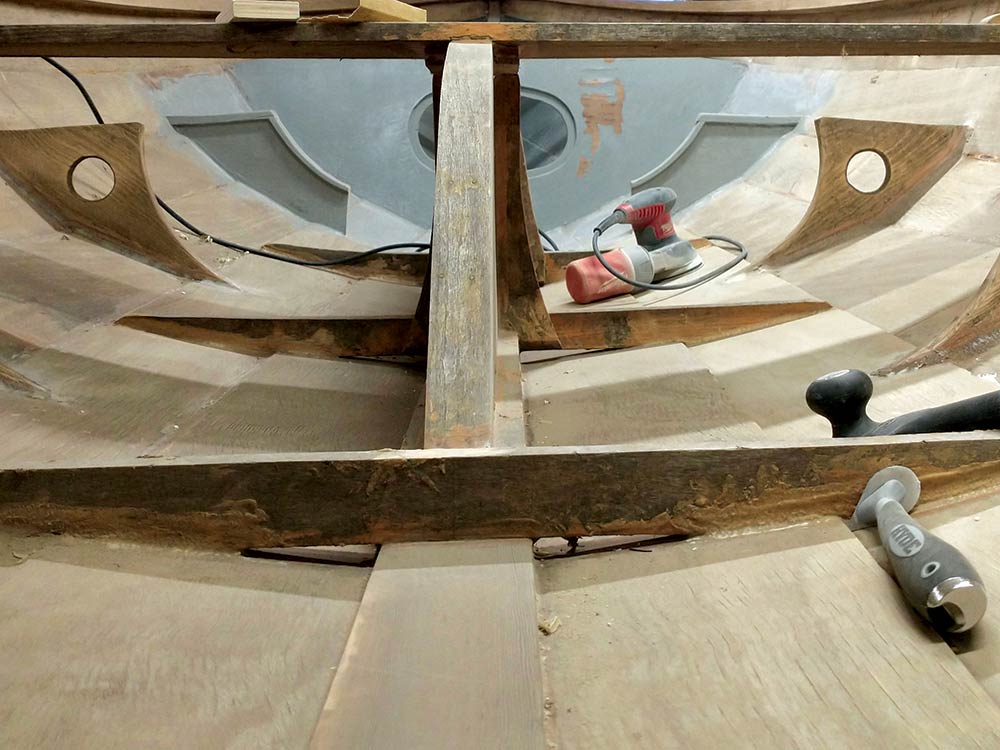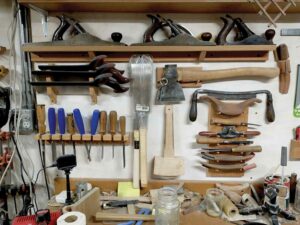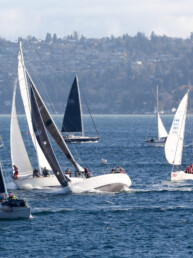Boats are dreams. The ones we want, the ones we build — even the ones that just sit collecting rainwater. All of them embody those aspirations. The dream boat represents different aspects of our identity and personifies the way we want to present ourselves to the world and our fellow boaters. Do we want to appear fast and sleek? Is practicality and self-propulsion more central? Or is the act of building, of showing the world, or yourself, that we can create something of function or beauty enough?
On a boatyard stroll, most sailors have noticed a once-proud hulk shrouded in poly tarps and wondered, could I fix that? And is there a boater who hasn’t whiled away a winter’s afternoon pursuing Craigslist, just to see if a more perfect craft exists out there? But how many of us have actually acted on the impulse to chase that unfulfilled dream?
Rory Banyard did just that…

Following his doctor’s orders to reduce stress, he traded the news for the online boat classifieds. One day he found an advertisement titled “Dead Man’s Dream.” Later, he emailed me: “I’m buying this half-finished boat (more than half, really) that I’m 98% sure is an Oughtred Arctic Tern. It’s too much of a deal to pass up (and I possibly have a boat-rescuing problem anyway) but I don’t have the time or space to finish it.”
Rory learned that when the original builder passed away, the boat was pushed along to several people, until it was eventually put up for sale. His email included a photo of an open wooden boat at the edge of a pastoral scene, its deck beams covered in dew and a small pool of water and leaves in the bilge. The wooden centerboard trunk and thwart had silvered, and only a portion of the interior was painted. The hull, a rich, midnight blue, hinted at what could be. Still, a lot of work and a dose of uncertainty would be involved in its restoration and completion. Regular readers will know that this is a design that has a special place in my heart, since many of my small-boat adventures have been on my own Oughtred Arctic Tern, Rowbird. Like me, Rory was drawn to the boat’s pumpkin seed shape and classic lines; and I wanted to help the dream become real.
I connected Rory with fellow Portlander, Bill Wessinger of Wessinger Woodworks. He had built several small boats himself, and despite having just welcomed a new baby, Bill signed on to help complete the project. He was optimistic. “It looks a bit rough and weathered at this point,” he said. “But the original builder did a good job, and the wood is still sound. He would finish the build, he told me, “to the point where it’s ready for paint and varnish.”
Over the next year, I made several visits to Bill’s basement shop to observe the progress and to hear his thoughts on the project. What was it like to work on something that wasn’t his own creation? I wondered. “Most of the things I make, I build from scratch,” Bill told me. “And I do everything except the upholstery when I build chairs. I end up with a sense of ownership for the entire process.” That wouldn’t be the case here, he acknowledged, but this only made the project more special. “I imagine the original builder would be glad to know that someone would pick up the reins and complete the project. That his dream would someday be on the water.”
Bill always talked confidently about the project. “It’s just the same working on a bigger boat as a smaller one,” he once told me. Cranking out new hollow, bird’s mouth spars, he took obvious pride in the complex joinery that will be invisible once completed.
Bill saw things in the wood that Rory and I might have missed, like where a plank was spiled properly; and he could distinguish one species of wood from another. If he fretted a little about the project, it was only because the original builder sometimes chose curious or inappropriate wood, like red oak, which is known to be too porous to hold paint or glue well.
There were other mysteries, like the centerboard. The builder constructed a centerboard trunk without a hole for a pin, which would normally allow the centerboard to pivot. Bemused, Bill showed me a template the previous owner made for the board itself — which wasn’t to plan, and didn’t fit in the trunk.
Working on another person’s boat can be a challenge, but I admired how Bill didn’t bog down in thought. Rather, he was always ready with clever solutions that kept the project moving along. He explained that he tried to understand the original builder’s vision while communicating and collaborating with its current owner, Rory, about the opportunities and constraints of the rebuild. There was a lot of back and forth, with Bill trying to give Rory choices and explaining the pros and cons and the costs of different decisions.
 As the seasons changed, I enjoyed coming by and seeing the wood shavings on Bill’s workshop floor. It signaled that progress was being made, and no one had given up on the dream. One day when I arrived, the boat was on its side, since Bill had figured out how to drill a hole through the trunk and had fashioned a proper centerboard, which now extended and retracted smoothly in its slot. Later, Bill posted a subtly ecstatic video on his Instagram account to celebrate.
As the seasons changed, I enjoyed coming by and seeing the wood shavings on Bill’s workshop floor. It signaled that progress was being made, and no one had given up on the dream. One day when I arrived, the boat was on its side, since Bill had figured out how to drill a hole through the trunk and had fashioned a proper centerboard, which now extended and retracted smoothly in its slot. Later, Bill posted a subtly ecstatic video on his Instagram account to celebrate.
The rebuild consisted of a series of individual projects, from making benches to completing the flotation tanks. Sometimes one of these went particularly smoothly, taking less time than anticipated; but other tasks, like building the spars, took over 50% longer than originally estimated.
Over the weeks and months, the list of projects began diminishing, leaving an array of smaller tasks to be accomplished. Hanging out after a shop visit, I asked Rory if he ever worried about getting in over his head, or over his budget. He seemed unfazed. “I think I have some tolerance for risk,” he said. “I’ve run an independent, project-based business for 25 years. This didn’t seem like that crazy of a proposition.”
Come late summer, the decks were laid, the hatches installed, and the spars complete. Rory hauled the boat home to paint, varnish, and rig. I went to visit one day and watched him labor in the cockpit, wielding a paintbrush and wearing a respirator. Comfortably upwind, I asked when he thought he’d be done and where he hoped to sail the boat.
Rory and his teenage son hope to sail and row the boat in the Salish Sea, he told me; in the mountain lakes, and anyplace to “get off the road, sail places and camp.” He worried a bit about some runs in the paint, but I could see that he was on track to complete his work before the rains began, and to really start using the boat next season.
Some little things about the boat weren’t quite to his liking, Rory told me, like the rails, which weren’t perfectly fair. “But maybe,” he told me, “that’s part of the charm of the story.”
Looking at the nearly completed vessel, and considering the work that Bill and Rory had put into her, I had to agree. The slight flaws only added to the boat’s character and served as a reminder of its history. Begun by a sailor who crossed the bar before he could complete it, then rescued by two others who never knew him, the boat was on the brink of new adventures — and my friends were one step closer to fulfilling a dream.
Bruce Bateau sails and rows traditional boats with a modern twist in Portland, Oregon. His stories and adventures can be found at www.terrapintales.wordpress.com.
Bruce Bateau
Bruce Bateau sails and rows traditional boats with a modern twist in Portland, Ore. His stories and adventures can be found at www.terrapintales.wordpress.com






